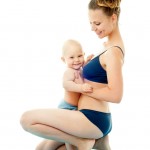
Some of the most common concerns of women I see in the office relate to the changes in their body following pregnancy and childbirth. First, let me say that pregnancy and childbirth are amazing and beautiful. Childbirth is truly a miracle and there is no greater joy than having children. Unfortunately, many women are disappointed and dissatisfied with the way their body looks after giving birth. I typically see patients as early as around 30 and into their 50s for cosmetic improvements after having children. Common complaints include:
- Stretched abdominal skin
- Localized fat of the abdomen and sides
- A weakened abdomen with a lower “pouch”
- An indented C-section scar with over-hang of abdominal skin above
- Localized fat of the inner or outer thighs (“saddle bags”)
- Deflated or sagging breasts
Many of these issues relate to the physical changes of carrying the baby, delivering the baby, breast feeding or hormonal changes. Let’s discuss each of these changes and how they can be addressed:
Stretched Abdominal Skin
After carrying a 7-9 pound baby for several months, it’s no wonder how the skin of the abdomen can become stretched out and loose. However, in my opinion, genetics may be more important than the size of the baby. I frequently see very petite women in the office that carried large full-term babies and have virtually no loose skin or stretch marks. Stretch marks or striae represent a permanent injury to the dermis layer of the skin that occurs from expansion of the skin at a rate faster than it can accommodate. It may have more to do with the rate of weight gain than the total amount of weight gain. Genetics no doubt also play a role and when I see patients without stretch marks, many tell me that their mothers didn’t get them either. Contrary to wives’ tales, there is nothing that can prevent stretch marks. Period. There is no magic lotion or potion that can prevent them, and in my opinion, any product that promises to do that is bogus. Using a good moisturizer may make the skin feel better but there is no evidence that cocoa butter or other emollients help prevent injury to the dermis layer of the skin when it is expanded too quickly. Likewise, there is no miracle cure for stretch marks short of surgical excision. When an abdominoplasty or tummy tuck is performed, if the stretch marks are confined to the level below the belly button, those would be removed when that skin is removed. If there are stretch marks above the belly button, those would remain albeit lower on the abdomen now that that skin has been brought down to the pubic hairline. Lasers and other medical devices touted to improve stretch marks are virtually worthless. They provide minimal if any improvement and are probably not worth the time and cost of treatments.
Tummy tuck (abdominoplasty): The most common procedure performed to address concerns related to the abdomen post-pregnancy is an abdominoplasty. There is a distinction between a full tummy tuck and a mini tummy tuck. In a full tummy tuck essentially all the skin of the lower abdomen from the belly button down is removed. Any and all stretch marks present on the skin of this area is removed, obviously. The lower end of the skin remaining is then brought down to the lower incision placed within the pubic hairline. Because that skin has been brought downwards, a new hole for the belly button is made; the belly button itself remains the same and is on the same location on the body. If an indented or otherwise unsightly C-section scar is present this can be removed with the rest of the skin excess. In addition, in a full abdominoplasty the abdominal muscles are tightened. Typically following pregnancy the rectus abdominus muscles have separated and I routinely repair this every time I perform a full tummy tuck. If this is not done, the skin might be tight but there would still be a lower abdominal bulge or “pouch” present. The lower abdominal incision is significant, often going from hip to hip, but it’s kept low and is usually hidden in the bikini line.
A mini tummy tuck involves removal of less skin — typically in an individual who doesn’t have enough excess below the belly button to warrant removal of all of that area. This may also involve tightening of the abdominal muscles and can be combined with liposuction of the abdomen, love handles, hips or other areas. The incision of a mini abdominoplasty is less extensive than a full tummy tuck.
Liposuction: Much confusion exists regarding liposuction. It is certainly not a method of weight loss and is not a substitute for a healthy diet and exercise. It is best suited for individuals who are at or close to their ideal body weight and simply have areas that have been resistant to diet and exercise. Localized fat of the abdomen, love handles (“muffin top” area), hips, inner and outer thighs, arms, neck, back and bra fat area are ideal. Typically not much skin tightening is achieved with liposuction and often it is combined with abdominoplasty. For example, liposuction of the love handle area, the hips and the thighs is frequently added to a tummy tuck to provide an optimal result. For those women that simply have localized excess fat of the abdomen without loose skin liposuction alone may provide a good result.
Deflated or Sagging Breasts
These two issues often but not always go hand-in-hand. Many women find that their breast size has decreased considerably following childbirth and often there is a loss of upper breast volume and projection. Breastfeeding may contribute to this but is not necessary for it to occur. Droopiness or sagging of the breasts is also another complaint I hear from some women following pregnancy. Significant sagging is called ptosis [tóssiss] in plastic surgery parlance. As the breast drops and the position of the nipple lowers, sometimes a breast lift (mastopexy) is done to elevate the position of the nipples, tighten the loose skin and restore fullness to the upper pole of the breast. Typically an implant is also placed to provide optimal fullness and projection. If an implant is not used the breasts could be considerably smaller. Even though a breast reduction per se has not been done, the process of removing the loose skin to lift and tighten the breast results in a smaller size. Often we make up that difference by placing a small implant, which also helps restore upper breast fullness. If a small degree of sagging or ptosis is present, an implant alone without a formal breast lift operation may be all that is needed.
As you can see, the term “Mommy Makeover” can mean a variety of different things, depending on the concerns a woman has. One operation does not fit all patients, and multiple procedures can be done at the same time or in two or more stages.
For more information about mommy makeover, please contact Physician’s Center for Beauty by calling (502) 897-7546.


